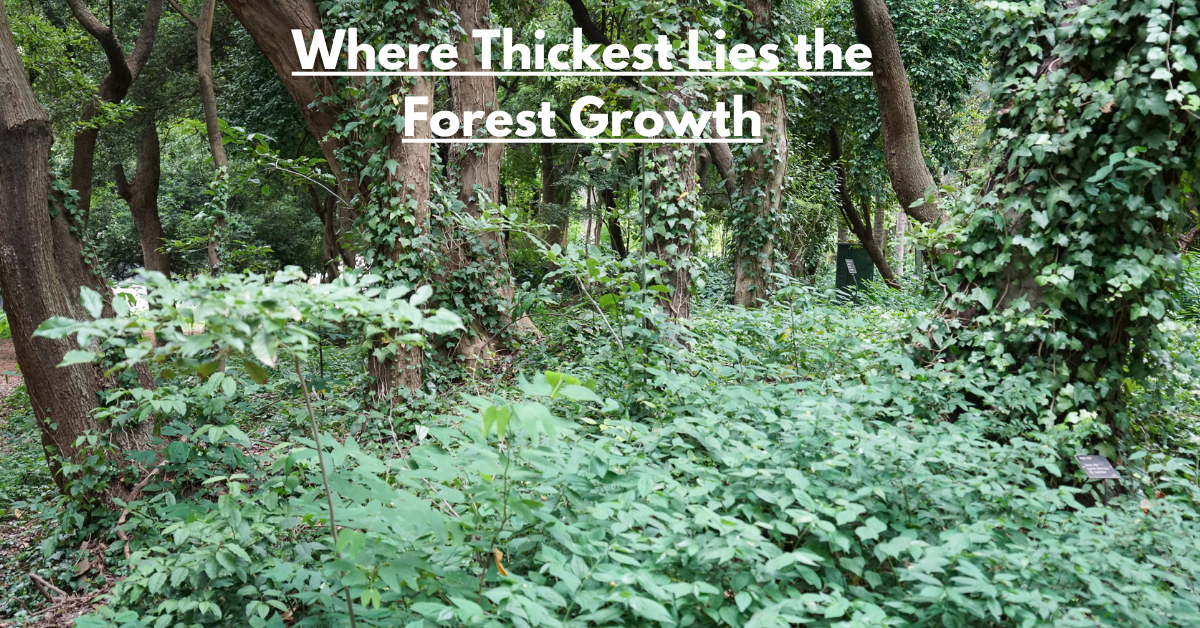Where Thickest Lies the Forest Growth: In the peaceful grasp of nature, where thickest lies the woodland development, we find a domain of charm and biodiversity. Woodlands, with their towering trees and rich undergrowth, are vital in maintaining life on our planet. This article digs into the importance of woodlands, their assorted environments, and the significance of preservation efforts.
The Grandness of Forests
Forests are endless areas secured transcendentally with trees and different greenery. They are classified into distinctive sorts based on their topography, climate, and trees. From the thick rain woodlands of the Amazon to the taiga coniferous forests, each biological system harbors notable species and contributes mainly to the worldwide environment.
Types of Forests
- Tropical Rain woodlands: Found close to the equator, these timberlands are characterized by high temperatures and precipitation, cultivating unparalleled biodiversity.
- Temperate Timberland: Direct climates and regular changes characterize these timberlands, home to deciduous trees that shed their leaves in autumn.
- Coniferous Woodlands: Transcendent woodlands composed of cone-bearing trees like pines and firs flourish in colder climates and frequently retain their greenery year-round.
Key Takeaways Where Thickest Lies the Forest Growth:
- Allegorical Profundity infers an area or state where something is most copious or concentrated, whether it’s exacting woodland development or something metaphorical like challenges, openings, or knowledge.
- Focus and Investigation: It empowers investigation and examination into densely populated or complex areas, proposing that more profound bits of knowledge or rewards may be found where things are most concentrated.
- Symbolism of Development: Woodlands symbolize development, life, and the everyday world. The state suggests that critical disclosures or encounters regularly happen where growth is most incredible or impediments are most significant.
- Philosophical Reflection: It welcomes reflection on where one chooses to enter consideration or exertion, proposing that handling the most challenging or complex angles can lead to the most significant understanding or accomplishment.
Biodiversity Potshots

Where thickest lies the timberland development, biodiversity thrives. Timberlands are centers of life, lodging endless species of plants, creatures, creepy crawlies, and microorganisms. This rich biodiversity is pivotal for environmental adjustment, providing environments, nourishment sources, and medications that maintain life both inside and beyond their borders.
Biodiversity shots are locales of critical biological significance due to their remarkable concentration of endemic species and high levels of biodiversity. These regions are essential for preservation endeavors since they harbor many species found nowhere else on Soil and are in danger from human activities such as territory annihilation, climate alteration, contamination, and intrusive species.
Wildlife Diversity
Forests support various natural life, from the tricky pumas of South American rain timberland to the notorious bears and wolves of North American forests. Each species plays an imperative part in the biological system, contributing to supplement cycling, proliferation, and predator-prey dynamics.
Wildlife differences allude to the assortment of species and environments displayed in a specific geographic zone or territory. They are a crucial viewpoint of biodiversity, which includes all life forms on Soil. The significance of natural life’s differing qualities cannot be exaggerated, as they play a pivotal part in maintaining the adjustment of biological systems and supporting life on our planet.
- Ecosystem Solidness: Each species inside a biological system has a particular part or mainly to satisfy. This interdependency makes a difference in maintaining the environment steadily. For example, predators offer assistance in controlling prey populations; herbivores control plant development and break down natural matter. A misfortune of natural life differing qualities can disturb these connections, leading to biological system awkwardness and potential collapse.
- Genetic Differences: Natural life’s differing qualities, moreover, envelop hereditary variety inside species. This hereditary variety is significant for adjustment and versatility in the face of natural changes such as climate change or disease flare-ups. It permits species to advance and survive over time.
- Economic Significance: Natural life differences contribute to economies through tourism, entertainment, and characteristic asset administration. Numerous nations depend on ecotourism as a major source of income, drawing in guests who want to encounter differing natural life in their common habitat.
- Cultural Importance: Natural life holds social and otherworldly centrality for numerous communities worldwide. Innate people groups regularly have profound social associations with particular species or environments, seeing them as a portion of their character and heritage.
- Ecological Administrations: Nature provides fundamental biological administrations such as fertilization, seed dispersal, supplement cycling, and soil arrangement. These administrations are essential for the workings of environments and horticulture and directly affect human well-being.
- Threats to Natural Life Differing qualities: In spite of their significance, natural life faces various dangers, fundamentally due to human activities. Environment devastation, contamination, climate alteration, poaching, and intrusive species are a few of the primary components driving species termination and the misfortune of biodiversity globally.
- Conservation Endeavour: Preservation endeavors aim to relieve these dangers and protect natural life differences. This incorporates building up ensured ranges, actuating economical land-use hones, upholding natural life laws, captive breeding programs, and raising mindfulness about the significance of biodiversity conservation.
- Global Effect: The unfortunate combination of natural life’s differing qualities influences nearby environments and has worldwide results. It can disturb nourishment chains, diminish biological system versatility, and decrease the planet’s capacity to support life as we know it.
Plant Diversity
Woodlands’ greenery ranges from towering hardwoods to fragile plants and greenflies. Therapeutic plants, timber species, and uncommon orchids are among the botanical treasures found inside timberland ecosystems.
Plant differences allude to the endless cluster of distinctive plant species on Soil, including a wealthy embroidered artwork of shapes, capacities, and environmental parts. This differing quality is significant for the well-being of biological systems and benefits human societies.
Firstly, plants establish earthly environments, shaping the premise of nourishment networks and giving living space and food for incalculable life forms. From towering trees in rain timberland to modest greenness in Cold tundra, each plant species plays a particular part in its biological system, contributing to supplement cycling, soil arrangement, and water regulation.
Plant diversity likewise supports worldwide nutrition security. Moreover, wild plants continue to be a source of unused qualities and characteristics that can be bred into crops to improve yields and dietary quality.
- Beyond their environmental and agricultural significance, plants offer various social, therapeutic, and financial benefits. Innate societies worldwide have profound otherworldly associations with particular plants, utilizing them in customs and ceremonies. Conventional pharmaceutical frameworks intensely depend on plants to treat afflictions and create present-day pharmaceuticals. Financially, plants contribute to businesses extending from timber and materials to beauty care products and bio powers, supporting jobs globally.
Environmental Benefits

The benefits of timberland extend far beyond their naturally differing qualities. Timberlands serve as carbon sinks, retaining carbon dioxide from the climate and moderating climate change. They also direct water cycles, anticipate soil disintegration, and filter and manage water assets, making them important to human well-being.
Climate Regulation
Trees assimilate CON and discharge oxygen through photosynthesis, contributing to cleaner discussion and climate adjustment. Deforestation disturbs this adjustment, discharging away carbon and contributing to nursery gas emissions.
Water Cycle Regulation
Forests act as characteristic wipes, retaining water and diminishing the chance of surges downstream. Their root frameworks upgrade soil piousness and anticipate disintegration, keeping up the richness of encompassing landscapes.
Essential Forms in the Water Cycle
- Evaporation: Sun-powered radiation warms the Earth’s surface, causing water to dissipate from seas, waterways, lakes, and soil into the environment as water vapor.
- Condensation: As warm, sodden discusses rises in the air, and it cools, driving the condensation of water vapor into little beads or ice gems and shaping clouds.
- Precipitation: Condensed water beads in clouds develop bigger until they drop back to the Earth’s surface as precipitation, which incorporates rain, snow, hail, or hail.
- Infiltration and Runoff: Precipitation that reaches the Earth’s surface may either penetrate the soil, renewing groundwater and supporting vegetation, or stream over the surface as runoff into streams and inevitably back into oceans.
- Transpiration: Plants retain water from the soil through their roots and discharge water vapor through little pores in their clears (tomatoes) in a preparation called transpiration, contributing to air dampness and cooling.
Natural Control of the Water Cycle
- Solar Vitality: Sun-powered radiation drives dissipation and powers air circulation designs, impacting where and when precipitation occurs.
- Topography: Mountain ranges and landforms impact precipitation designs by causing discuss masses to rise and cool, improving condensation and precipitation on windward slants (orthographic rainfall).
- Vegetation: Woodlands and vegetation play a pivotal part in controlling the water cycle through transpiration, impacting nearby and territorial climate designs and the accessibility of moisture.
- Ocean Streams: Sea streams transport warmth and dampness over the globe, affecting territorial climates and precipitation patterns.
Human Affect on the Water Cycle
- Water Administration: Human activities such as water system design, dam development, and water extraction for mechanical and household use can change characteristic water stream designs, influencing nearby and territorial hydrology.
- Deforestation: Clearing woodlands decreases transpiration rates, modifies nearby climate designs, and can lead to diminished precipitation and expanded runoff.
- Urbanization: Asphalt and buildings in urban zones disturb common invasion forms, expanding surface runoff and modifying nearby hydrology.
- Climate Alter: Expanding worldwide temperatures due to human-induced climate alteration are changing precipitation patterns, powering dry seasons and surges in different districts, and disturbing the water cycle’s regular adjustment.
Threats to Forests

Despite their biological significance, timberlands confront various dangers from human activities. Deforestation for farming, logging, and conurbation poses a critical hazard to worldwide woodland cover. Climate change worsens these risks, modifying woodland environments and undermining helpless species.
- Deforestation: One of the most critical dangers to woodlands, all-inclusive, is deforestation, driven fundamentally by rural extension, logging (both lawful and illicit), foundation advancement, and urbanization. This comes about due to the enormous misfortune of timberland cover and environmental fragmentation.
- Climate Alter: Timberland is exceedingly touchy to climate alter impacts such as changed precipitation designs, expanded recurrence of extraordinary climate occasions (like dry spells and storms), rising temperatures, and moving environmental zones. These changes can disturb woodland environments, influencing species dispersion, woodland recovery, and biodiversity.
- Invasive Species: Presentation of intrusive species, whether plants, creatures, or pathogens, can out-compete local species for assets, disturb biological system adjust, and lead to the decay of local greenery and fauna. This risk is exacerbated by worldwide exchange and travel.
- Wildfires: Common and human-caused fierce blazes pose critical dangers to woodlands, particularly in locales inclined to dry spells and where fire concealment methodologies have changed standard fire administrations. Uncontrolled fires can lead to broad woodland misfortune and long-term environmental damage.
- Illegal Logging and Poaching: Unsustainable logging hones, regularly unlawful, contributes to timberland corruption and biodiversity misfortune. Poaching of natural life encourages, disturbs environmental equalization, and debilitates imperiled species.
- Air and Water Contamination: Contamination from mechanical exercises, farming, and urban runoff can debase woodland well-being by influencing soil quality, water accessibility, and the well-being of plant and creature species inside the timberland ecosystem.
- Infrastructure Improvement: Streets, dams, and other framework ventures can part woodlands, driving to territory misfortune, expanded human-wildlife clashes, and disturbance of movement courses for numerous species.
- Overgrazing: Touching by animals and other creatures can debase woodlands by trampling vegetation, compacting soils, and lessening plant recovery. Overgrazing can lead to desertification in a few regions.
- Climate Alter Relief Endeavour: Incomprehensibly endeavor to moderate climate change, such as large-scale forestation and reforestation ventures, which can now and then present non-native species or disturb neighbor biological systems if not carefully arranged and managed.
- Human Settlements: Extending human settlements into forested zones can lead to misfortune in living space, expanded natural life poaching, presentation of intrusive species, and increased hazard of rapidly spreading fires due to human activities.
Deforestation Impact
The clearing of timberland for agribusiness and timber extraction not only reduces biodiversity but also releases carbon into the climate, contributing to worldwide warming. Maintainable woodland administration hones are fundamental to moderate these impacts.
Conservation Efforts
Efforts to moderate and reasonably oversee woodlands are basic to protecting their environmental judgment and the services they provide. Preservation activities range from secured zone assignments to community-based timberland administration and reforestation projects.
Protected Areas
National parks, natural life preserves, and UNESCO World Legacy Destinations are built to ensure perfect timberland biological systems and moderate imperiled species. These ranges play a vital part in biodiversity preservation and scientific research.
Table for Where Thickest Lies the Forest Growth:
| Word | Syllables | Rhyme |
|---|---|---|
| Where | 1 | No rhyme |
| Thickest | 2 | -sickest |
| Lies | 1 | No rhyme |
| the | 1 | No rhyme |
| Forest | 2 | -rest |
| Growth | 1 | No rhyme |
Sustainable Practices
Adopting economical ranger service methods such as specific logging, ranger service, and forestation advances woodland recovery while meeting human needs for timber and rural items. Certification plans like FSLIC (Timberland Stewardship Board) guarantee capable timberland administration worldwide.
Sustainable hones envelop a wide range of methodologies and activities that protect the environment, cultivate social value, and guarantee financial learnability for current and future eras. These hones are significant in relieving the antagonistic impacts of climate change, decreasing asset exhaustion, and advancing a more advantageous planet overall.
One critical angle of feasible hones is natural stewardship, which includes limiting natural effects through different means such as decreasing carbon emanations, moderating water and vitality, securing biodiversity, and limiting squandering era. This can be accomplished through activities like receiving renewable vitality sources, actuating energy-efficient advances, honing mindful arrival utilization and horticulture, and advancing reusing and reusing of materials.
Social value is another essential sustainability measurement. It guarantees that financial improvement benefits all individuals while defending human rights and advancing reasonable trade-offs. This incorporates cultivating comprehensive communities, advancing access to instruction and healthcare, supporting reasonable trade-offs, and addressing social differences and inborn rights.
Economic sustainability is basic for the long-term practicality of businesses and communities, underlining ways to advance financial development without compromising natural or social well-being. This includes contributing to maintainable innovations and foundations, advancing maintainable utilization and generation designs, and integrating maintainability into corporate procedures and policies.
Education and mindfulness play a significant part in progressing feasible hones by enabling people and communities to make educated choices and take significant actions. This incorporates raising mindfulness about natural issues, advancing sustainable ways of life, and providing preparation and capacity-building programs to empower individuals to take part effectively in sustainable advancement activities.
FAQs About Where Thickest Lies the Forest Growth:
- Why are woodlands vital for biodiversity?
Forests harbor various living spaces that support a wide range of plant and animal species, contributing to worldwide biodiversity.
- How do woodlands contribute to climate regulation?
Forests retain carbon dioxide through photosynthesis and store carbon in their biomass, reducing nursery gas concentrations, which moderates climate change.
- What are the fundamental dangers to worldwide forests?
Deforestation, climate alteration change, illicit logging, and environmental environmental fracture are significant worldwide dangers confronting woodlands.
- How can people contribute to woodland conservation?
Individuals can bolster timberland preservation endeavors by advancing economic utilization, participating in reforestation activities, and advocating for arrangements that ensure timberland ecosystems.
Conclusion
Where the thickest woodland development lies, humankind finds not fair excellence but a pivotal partner in the battle for natural sustainability. By understanding and esteeming woodlands for their environmental noteworthiness, we can work together to guarantee their conservation for future eras.
In conclusion, where the timberland development is thickest, we discover not fair trees but a flourishing environment fundamental for life on Soil. Woodlands are storehouses of biodiversity, suppliers of imperative environmental administrations, and key players in climate control. Ensuring and moderating timberland is a natural basis and an ethical commitment for current and future generations.

